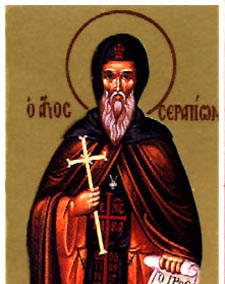Saint Serapion, Bishop of Thmuis in Lower Egypt

Saint Serapion lived in Egypt during the fourth century. He is known as “the Sindonite” because he wore only rough linen clothing (sindona). From the time of his youth he lived like the birds of the air (Matthew 6:26). He had no shelter, and for several days at a time he would eat no food, because he did not have money to buy bread. When he saw a beggar shivering from the cold, he gave him his sindon, and was left half-naked. He proved to be a prime example of philanthropy and mercy, distributing his own wealth, and whatever his faithful visitors gave him for himself, to the poor. Then he became a monk and lived in the desert of Sketis. He was dedicated to spreading the Word of God in many different ways.
Once he fell into the hands of a bandit, and by his powers of persuasion he managed to turn the tables on him, and made this robber a servant of God. He also managed to convert the Manichean heretic Lakedaimon to Orthodoxy.
A certain Greek philosopher, who wanted to test the monk’s honesty, gave him a gold coin and began to watch him. The Saint went to a bread merchant, took one loaf and gave the gold coin to the merchant, walking away with no idea of the coin’s value.
Saint Serapion led many people to the path of salvation in special ways. Once he sold himself into slavery to a Greek actor who wanted to convert to Christ. The actor was astonished by the righteous one’s holy life, and so he believed and was baptized with his family. He implored Saint Serapion to remain with him, not as a slave, but as a mentor and friend. The monk left, however, without taking the money that was offered to him.
Departing for Rome, Saint Serapion boarded a ship, but did not pay the sailors anything for his passage. At first, they began to reproach him for this, but when they saw that the Elder did not eat anything for five days, they began to feed him for the sake of God, and thereby fulfilled the commandment of the Lord. In Rome, the monk continued to travel, going from house to house, having nothing, gathering only spiritual riches for himself and for his neighbor.
Later he was made Bishop of Thmuis in Lower Egypt. He had been a disciple of Saint Anthony the Great (January 17), and later he wrote A Letter on the Death of Saint Anthony. He was also a friend and supporter of Saint Athanasios of Alexandria (January 18 & May 2). At the end of the nineteenth century a collection of liturgical texts, ascribed to Saint Serapion, was discovered.
In the end he returned to his beloved desert, where he reposed peacefully in deep old age in the year 370, an example for all the monks.
